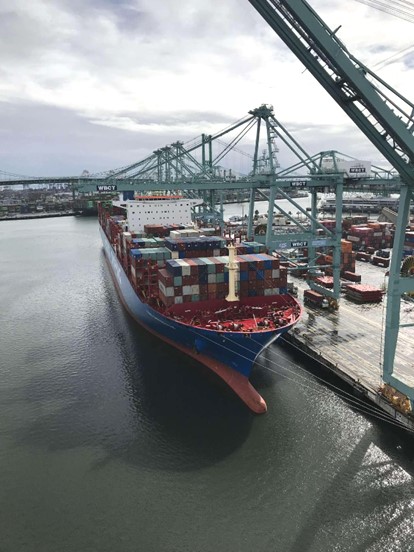By Chen Yiming, Shi Yuanhao, People's Daily
Along the west coast of the U.S., the Port of Los Angeles is a hive of activity, with massive container ships constantly coming and going.
Mark Wheeler, 70, retired 4 years ago from his position as vice president of the West Basin Container Terminal (WBCT) at the Port of Los Angeles. Although he now lives in South Carolina, Mark still cares deeply about the port where he worked for decades. Whenever he talks about his career, one exciting scene always comes to mind – a visit to the port by Xi Jinping, who serves as the Chinese President today.

It was on Feb. 16, 2012. Xi, then vice president of China, had a tour to a terminal of China's shipping giant COSCO at the Port of Los Angeles. According to Wheeler, he was serving as the terminal operations manager back then and witnessed a story of mutual benefit and win-win cooperation between the U.S. and China.
Wheeler said he never thought that a leader of a major country could be so approachable, adding that Xi shook hands with everyone and waved enthusiastically to crew members on cargo ships. It was like meeting an old friend, he noted.
The Port of Los Angeles is the largest container port in the United States and serves as the first stop for Chinese goods entering the United States across the Pacific Ocean.
In 2001, a COSCO subsidiary became a shareholder of the port, holding partial equity stakes in the WBCT at the Port of Los Angeles and the Pacific Container Terminal at the Port of Long Beach. This marked the beginning of rapid development for the Port of Los Angeles.
By 2012, the WBCT's annual container throughput reached 1.5 million twenty-foot equivalent units (TEUs), accounting for 10 percent of the total at the Port of Los Angeles and contributing $100 million in direct tax revenue to the federal and local governments.
Since 2012, COSCO has always adhered to the principles of practical cooperation and mutual benefit in serving the trade sector, and continuously expanded its shipping routes, capital investment, and technological input in the entire Los Angeles.
For many years, the Port of Los Angeles has played an important role in U.S.-China trade, said Wheeler, attributing the development of ports in the Los Angeles area to mutually beneficial cooperation between the two countries.
So far, COSCO has directly created about 2,400 jobs in the United States. Through partnerships with trucking companies, railways, tugboat services and other suppliers, COSCO's terminals have generated around 15,000 additional jobs in the country.
"COSCO actively promotes local economic and social development at the Ports of Los Angeles and Long Beach, striving to meet customers' transportation needs. Especially when supply chains get tight, we strive to tackle problems like insufficient capacity and port congestion," said Gu Quanlin, vice president of COSCO SHIPPING (North America).
According to Gu, during the peak of the COVID-19 pandemic in the United States, COSCO terminals in the country utilized multimodal transportation to swiftly deliver essential medical supplies to customers in the Midwest through the Port of Long Beach. This made a significant contribution to the local population's response to the pandemic.
Additionally, COSCO Shipping has strengthened management around ship speed reduction, shore power usage, near-shore emissions, and equipment emissions. This aligns fully with the Californian government's long-standing promotion of green principles.
Among all the terminals at the Ports of Los Angeles and Long Beach, COSCO terminals have always been at the forefront of protecting the ocean environment and marine life, said Paul Nazzaro, executive vice president of COSCO SHIPPING (North America).
The 130-km long Santa Barbara Channel by the Port of Long Beach is a major shipping lane, as well as one of the world's most important destinations for migrating blue whales. It is visited by many blue whales, humpback whales and fin whales from July to November each year. Excessive ship speeds would severely impact the whales.
Since 2018, COSCO has actively implemented the project of Protecting Blue Whales and Blue Skies. So far, it has carried out relevant eco-friendly operations on 111 voyages, making effective safety nets for marine life and lowering greenhouse gas and suspended particulate emissions.
From 2020 to 2022, COSCO won the top award of the "Protecting Blue Whales and Blue Skies" project, the "Sapphire Prize," given by the U.S. National Oceanic and Atmospheric Administration for three consecutive years.
Brian Peck, Chair of the Los Angeles Regional Export Council, stated that China is California's largest trading partner, and one-third of U.S.-China trade passes through the Ports of Los Angeles and Long Beach. California attracts more Chinese investment than any other U.S. state and is home to the largest population of Chinese students and visitors. The close ties between California and China reflect the intertwined interests of the United States and China and demonstrate the mutually beneficial essence of U.S.-China economic and trade cooperation.
Wheeler told People's Daily that he sincerely hopes that the two largest economies, the United States and China, can find more common ground and write more stories of cooperation and win-win outcomes through exchanges and dialogues.

